check engine TOYOTA CAMRY V20 1986 Service Information
[x] Cancel search | Manufacturer: TOYOTA, Model Year: 1986, Model line: CAMRY V20, Model: TOYOTA CAMRY V20 1986Pages: 2389, PDF Size: 84.44 MB
Page 285 of 2389
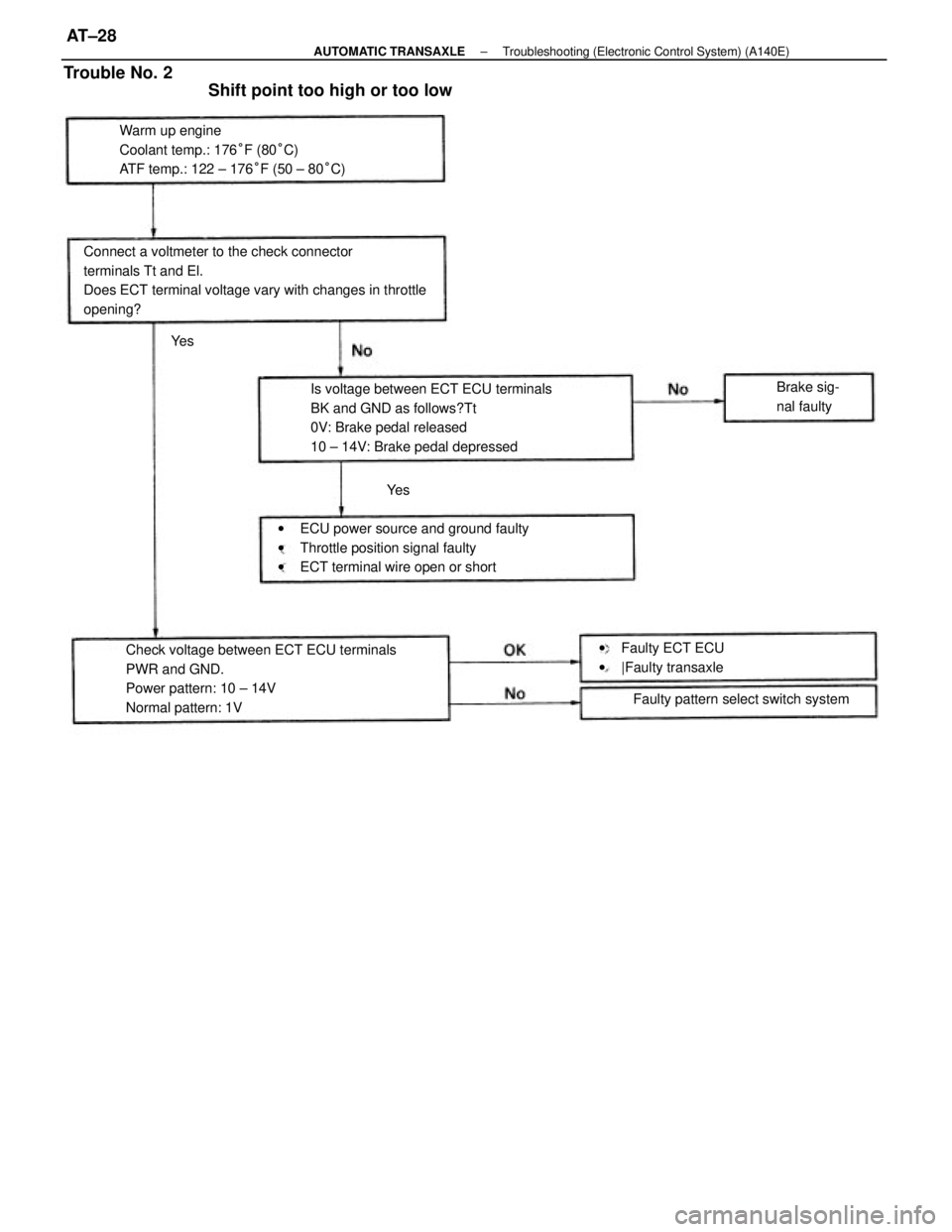
Connect a voltmeter to the check connector
terminals Tt and El.
Does ECT terminal voltage vary with changes in throttle
opening?
Check voltage between ECT ECU terminals
PWR and GND.
Power pattern: 10 ± 14V
Normal pattern: 1VIs voltage between ECT ECU terminals
BK and GND as follows?Tt
0V: Brake pedal released
10 ± 14V: Brake pedal depressed Warm up engine
Coolant temp.: 176°F (80°C)
ATF temp.: 122 ± 176°F (50 ± 80°C)
wECU power source and ground faulty
wThrottle position signal faulty
wECT terminal wire open or short
Faulty pattern select switch system
Shift point too high or too low
wFaulty ECT ECU
w|Faulty transaxle
Trouble No. 2
Brake sig-
nal faulty Ye s
Ye s
± AUTOMATIC TRANSAXLETroubleshooting (Electronic Control System) (A140E)AT±28
Page 287 of 2389
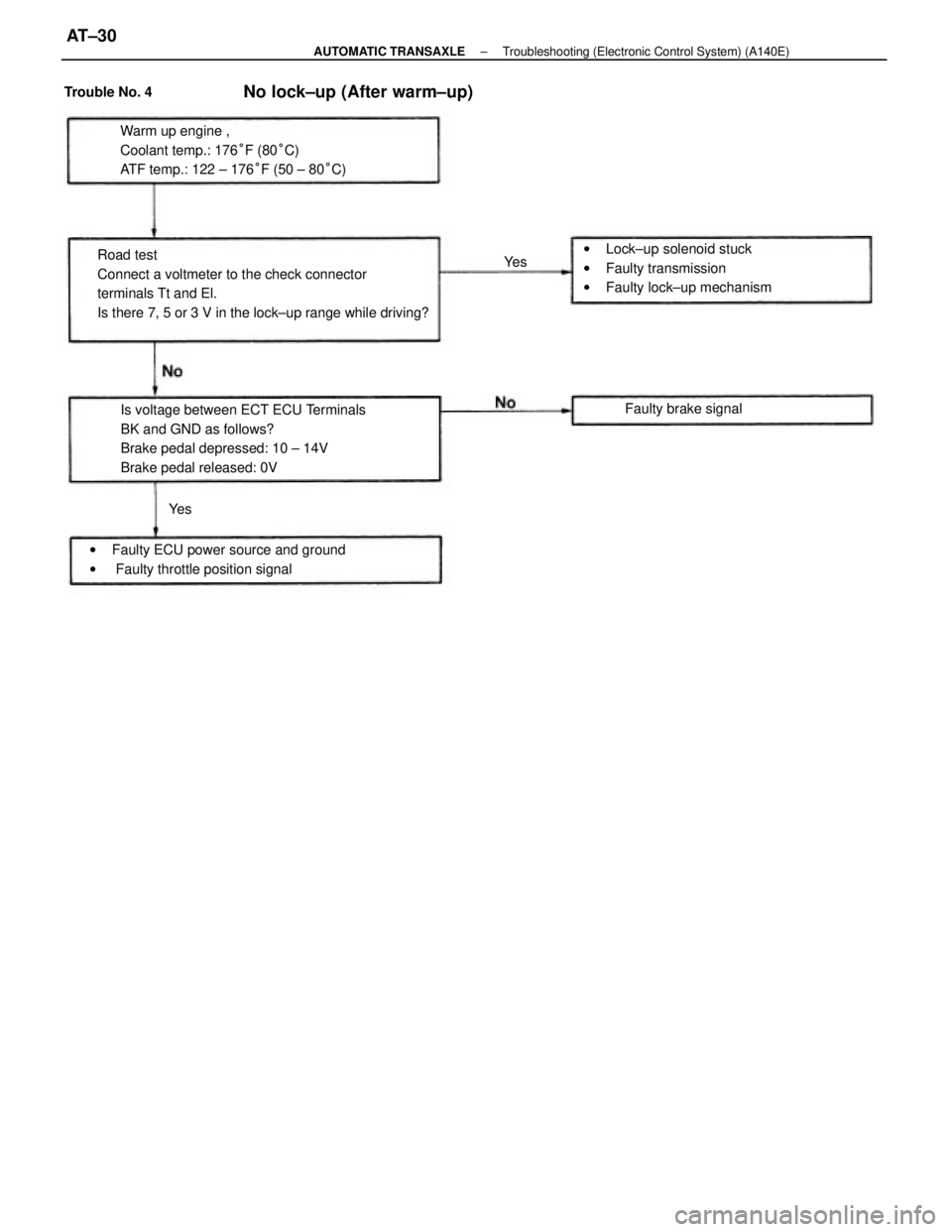
Road test
Connect a voltmeter to the check connector
terminals Tt and El.
Is there 7, 5 or 3 V in the lock±up range while driving?
Is voltage between ECT ECU Terminals
BK and GND as follows?
Brake pedal depressed: 10 ± 14V
Brake pedal released: 0V Warm up engine ,
Coolant temp.: 176°F (80°C)
ATF temp.: 122 ± 176°F (50 ± 80°C)
wLock±up solenoid stuck
wFaulty transmission
wFaulty lock±up mechanism
wFaulty ECU power source and ground
w Faulty throttle position signal
No lock±up (After warm±up)
Faulty brake signal Trouble No. 4
Ye s
Ye s
± AUTOMATIC TRANSAXLETroubleshooting (Electronic Control System) (A140E)AT±30
Page 288 of 2389
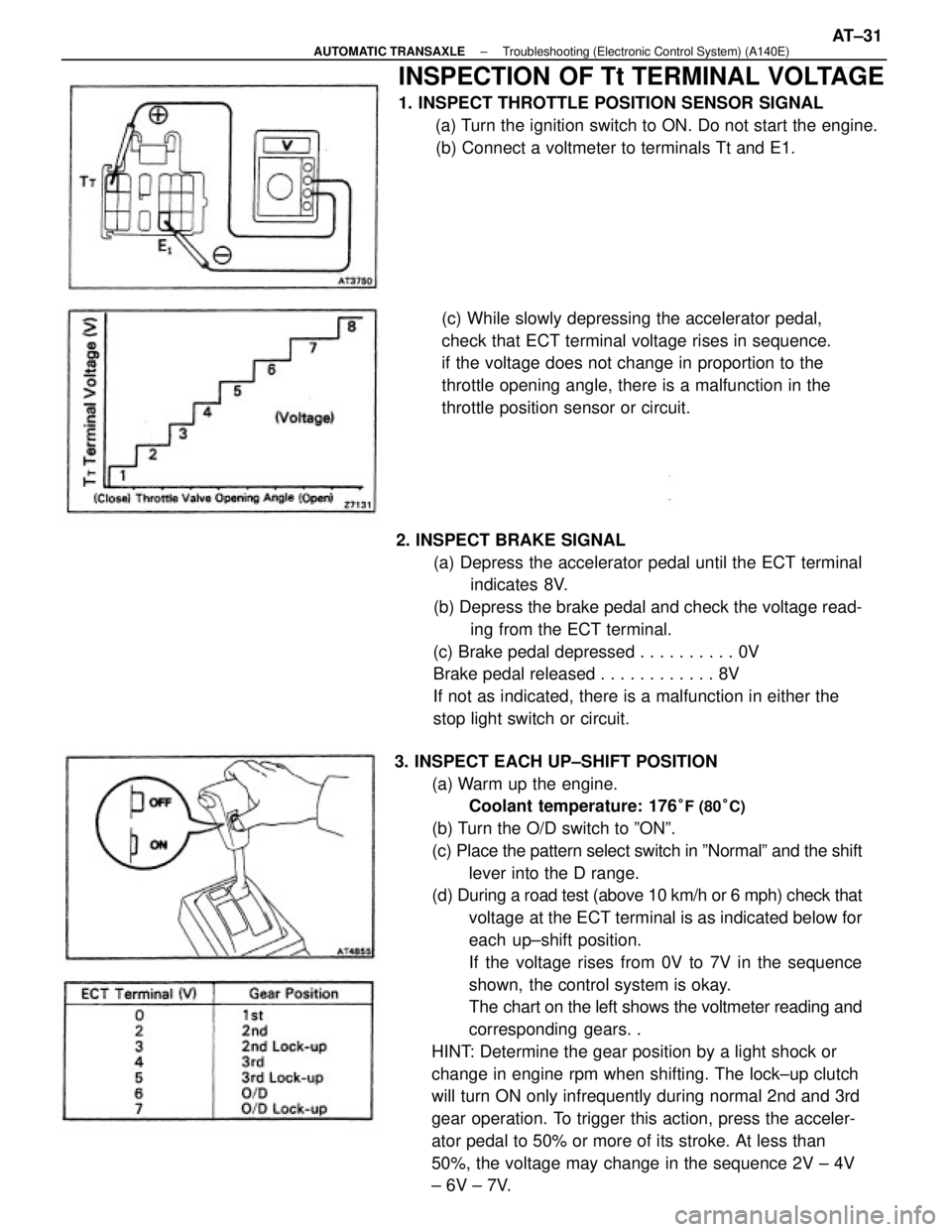
3. INSPECT EACH UP±SHIFT POSITION
(a) Warm up the engine.
Coolant temperature: 176
°F (80°C)
(b) Turn the O/D switch to ºONº.
(c) Place the pattern select switch in ºNormalº and the shift
lever into the D range.
(d) During a road test (above 10 km/h or 6 mph) check that
voltage at the ECT terminal is as indicated below for
each up±shift position.
If the voltage rises from 0V to 7V in the sequence
shown, the control system is okay.
The chart on the left shows the voltmeter reading and
corresponding gears. .
HINT: Determine the gear position by a light shock or
change in engine rpm when shifting. The lock±up clutch
will turn ON only infrequently during normal 2nd and 3rd
gear operation. To trigger this action, press the acceler-
ator pedal to 50% or more of its stroke. At less than
50%, the voltage may change in the sequence 2V ± 4V
± 6V ± 7V. 2. INSPECT BRAKE SIGNAL
(a) Depress the accelerator pedal until the ECT terminal
indicates 8V.
(b) Depress the brake pedal and check the voltage read-
ing from the ECT terminal.
(c) Brake pedal depressed . . . . . . . . . . 0V
Brake pedal released . . . . . . . . . . . . 8V
If not as indicated, there is a malfunction in either the
stop light switch or circuit.
INSPECTION OF Tt TERMINAL VOLTAGE
1. INSPECT THROTTLE POSITION SENSOR SIGNAL
(a) Turn the ignition switch to ON. Do not start the engine.
(b) Connect a voltmeter to terminals Tt and E1.
(c) While slowly depressing the accelerator pedal,
check that ECT terminal voltage rises in sequence.
if the voltage does not change in proportion to the
throttle opening angle, there is a malfunction in the
throttle position sensor or circuit.
± AUTOMATIC TRANSAXLETroubleshooting (Electronic Control System) (A140E)AT±31
Page 292 of 2389
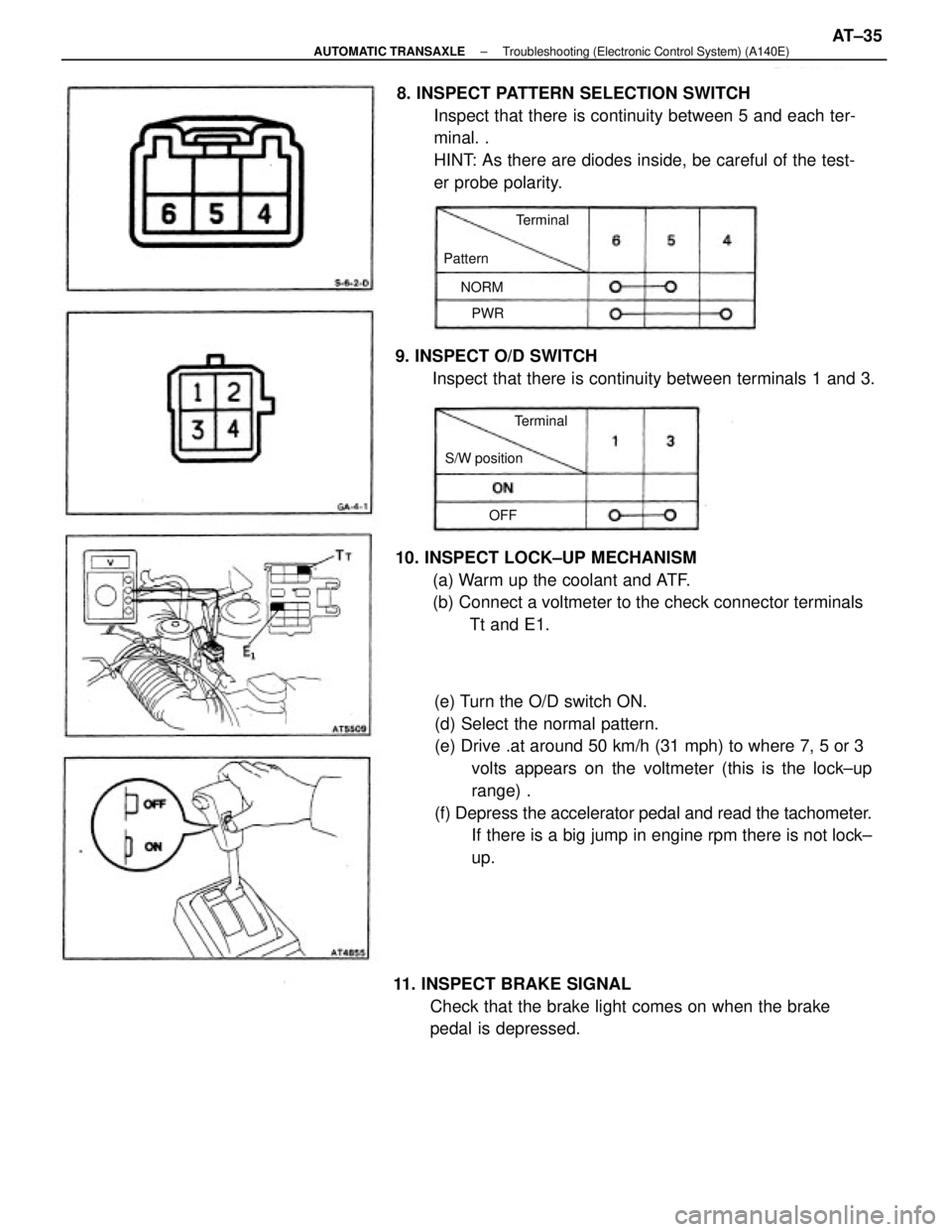
(e) Turn the O/D switch ON.
(d) Select the normal pattern.
(e) Drive .at around 50 km/h (31 mph) to where 7, 5 or 3
volts appears on the voltmeter (this is the lock±up
range) .
(f) Depress the accelerator pedal and read the tachometer.
If there is a big jump in engine rpm there is not lock±
up. 8. INSPECT PATTERN SELECTION SWITCH
Inspect that there is continuity between 5 and each ter-
minal. .
HINT: As there are diodes inside, be careful of the test-
er probe polarity.
10. INSPECT LOCK±UP MECHANISM
(a) Warm up the coolant and ATF.
(b) Connect a voltmeter to the check connector terminals
Tt and E1.
11. INSPECT BRAKE SIGNAL
Check that the brake light comes on when the brake
pedal is depressed. 9. INSPECT O/D SWITCH
Inspect that there is continuity between terminals 1 and 3.
S/W positionTerminal
Terminal Pattern
NORM
PWR
OFF
± AUTOMATIC TRANSAXLETroubleshooting (Electronic Control System) (A140E)AT±35
Page 293 of 2389
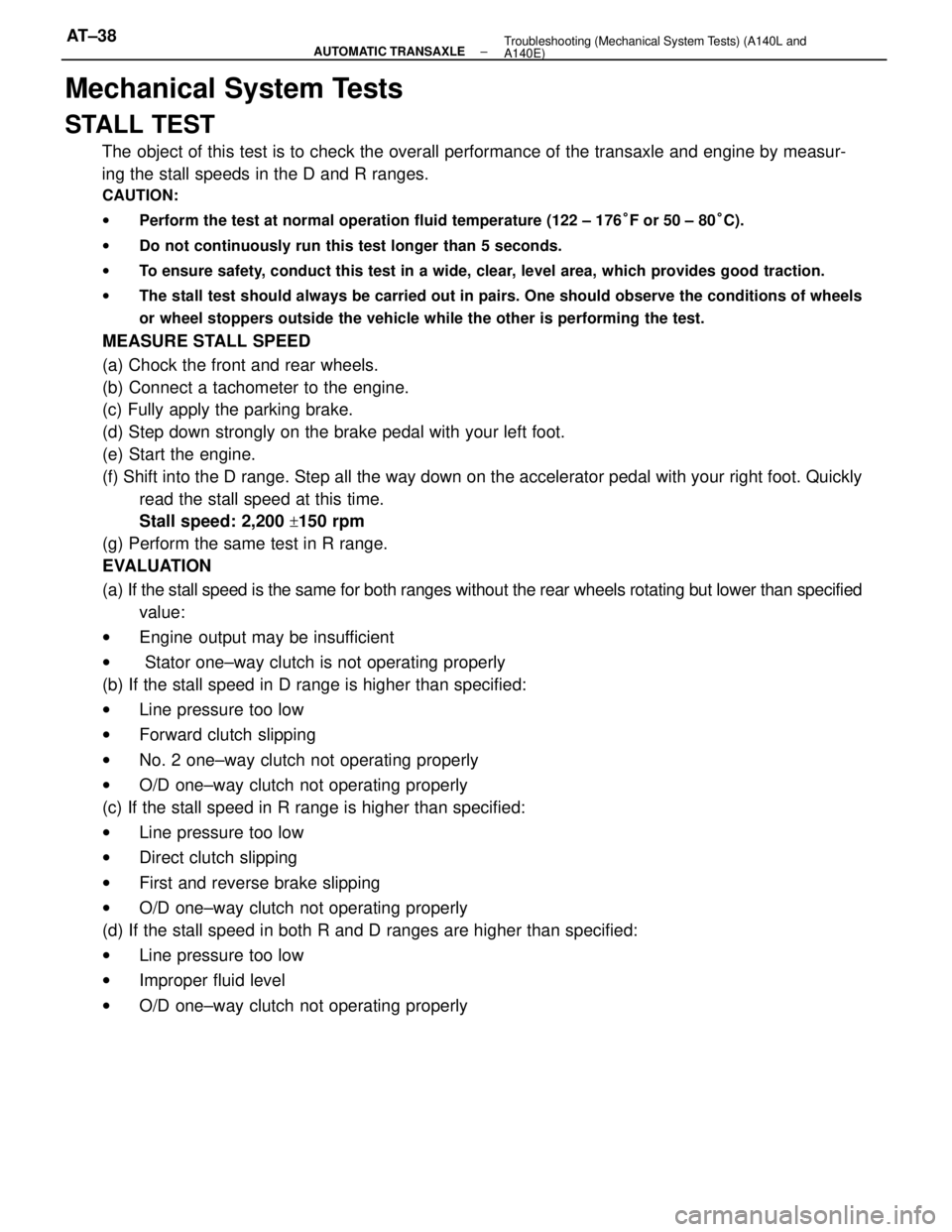
Mechanical System Tests
STALL TEST
The object of this test is to check the overall performance of the transaxle and engine by measur-
ing the stall speeds in the D and R ranges.
CAUTION:
wPerform the test at normal operation fluid temperature (122 ± 176°F or 50 ± 80°C).
wDo not continuously run this test longer than 5 seconds.
wTo ensure safety, conduct this test in a wide, clear, level area, which provides good traction.
wThe stall test should always be carried out in pairs. One should observe the conditions of wheels
or wheel stoppers outside the vehicle while the other is performing the test.
MEASURE STALL SPEED
(a) Chock the front and rear wheels.
(b) Connect a tachometer to the engine.
(c) Fully apply the parking brake.
(d) Step down strongly on the brake pedal with your left foot.
(e) Start the engine.
(f) Shift into the D range. Step all the way down on the accelerator pedal with your right foot. Quickly
read the stall speed at this time.
Stall speed: 2,200
+150 rpm
(g) Perform the same test in R range.
EVALUATION
(a) If the stall speed is the same for both ranges without the rear wheels rotating but lower than specified
value:
wEngine output may be insufficient
w Stator one±way clutch is not operating properly
(b) If the stall speed in D range is higher than specified:
wLine pressure too low
wForward clutch slipping
wNo. 2 one±way clutch not operating properly
wO/D one±way clutch not operating properly
(c) If the stall speed in R range is higher than specified:
wLine pressure too low
wDirect clutch slipping
wFirst and reverse brake slipping
wO/D one±way clutch not operating properly
(d) If the stall speed in both R and D ranges are higher than specified:
wLine pressure too low
wImproper fluid level
wO/D one±way clutch not operating properly
± AUTOMATIC TRANSAXLETroubleshooting (Mechanical System Tests) (A140L and
A140E)AT±38
Page 294 of 2389
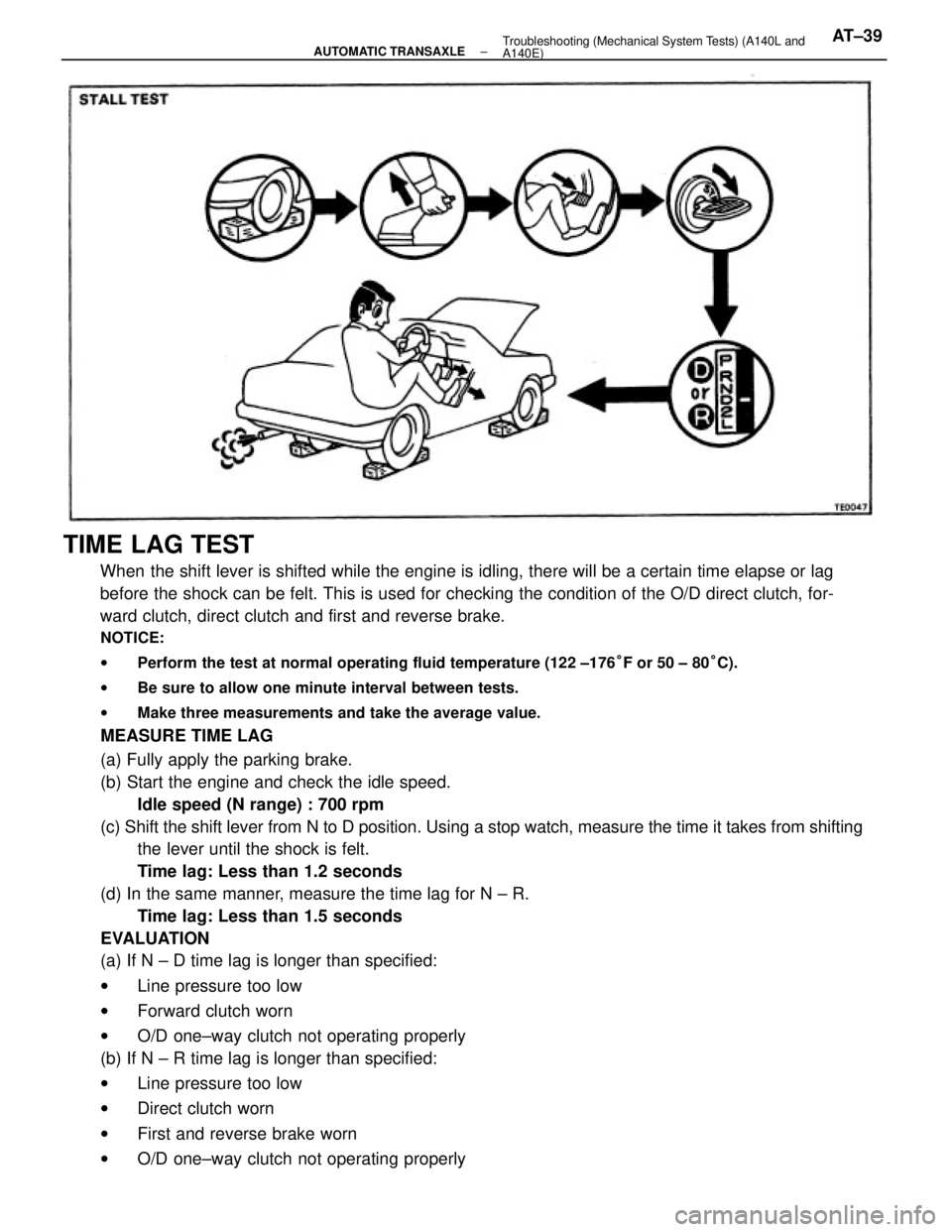
TIME LAG TEST
When the shift lever is shifted while the engine is idling, there will be a certain time elapse or lag
before the shock can be felt. This is used for checking the condition of the O/D direct clutch, for-
ward clutch, direct clutch and first and reverse brake.
NOTICE:
wPerform the test at normal operating fluid temperature (122 ±176°F or 50 ± 80°C).
wBe sure to allow one minute interval between tests.
wMake three measurements and take the average value.
MEASURE TIME LAG
(a) Fully apply the parking brake.
(b) Start the engine and check the idle speed.
Idle speed (N range) : 700 rpm
(c) Shift the shift lever from N to D position. Using a stop watch, measure the time it takes from shifting
the lever until the shock is felt.
Time lag: Less than 1.2 seconds
(d) In the same manner, measure the time lag for N ± R.
Time lag: Less than 1.5 seconds
EVALUATION
(a) If N ± D time lag is longer than specified:
wLine pressure too low
wForward clutch worn
wO/D one±way clutch not operating properly
(b) If N ± R time lag is longer than specified:
wLine pressure too low
wDirect clutch worn
wFirst and reverse brake worn
wO/D one±way clutch not operating properly
± AUTOMATIC TRANSAXLETroubleshooting (Mechanical System Tests) (A140L and
A140E)AT±39
Page 295 of 2389

HYDRAULIC TEST
PREPARATION
(a) Warm up the transaxle fluid.
(b) Remove the transaxle case test plug and connect the hydraulic pressure gauge.
SST 09992±00094 (Oil pressure gauge)
NOTICE:
wPerform the test at normal operating fluid temperature (122 ±176°F or 50 ± 80°C).
wThe line pressure test should always be carried out in pairs. One should observe the conditions
of wheels or wheel stoppers outside the vehicle while the other is performing the test.
MEASURE LINE PRESSURE
(a) Fully apply the parking brake and chock the four wheels.
(b) Start the engine and check idling rpm.
(e) Step down strongly on the brake pedal with your left foot and shift into D range.
(d) Measure the line pressure when the engine is idling.
(e) Press the accelerator pedal all the way down. Quickly read the highest line pressure when engine
speed reaches stall speed.
(f) In the same manner, perform the test in R range.
If the measured pressure are not up to specified values, recheck the throttle cable adjustment and
perform a retest.
kg/cm (psi, kPa)
Line pressure
R range D range
Idling
IdlingStall
Stall
± AUTOMATIC TRANSAXLETroubleshooting (Mechanical System Tests) (A140L and
A140E)AT±40
Page 297 of 2389
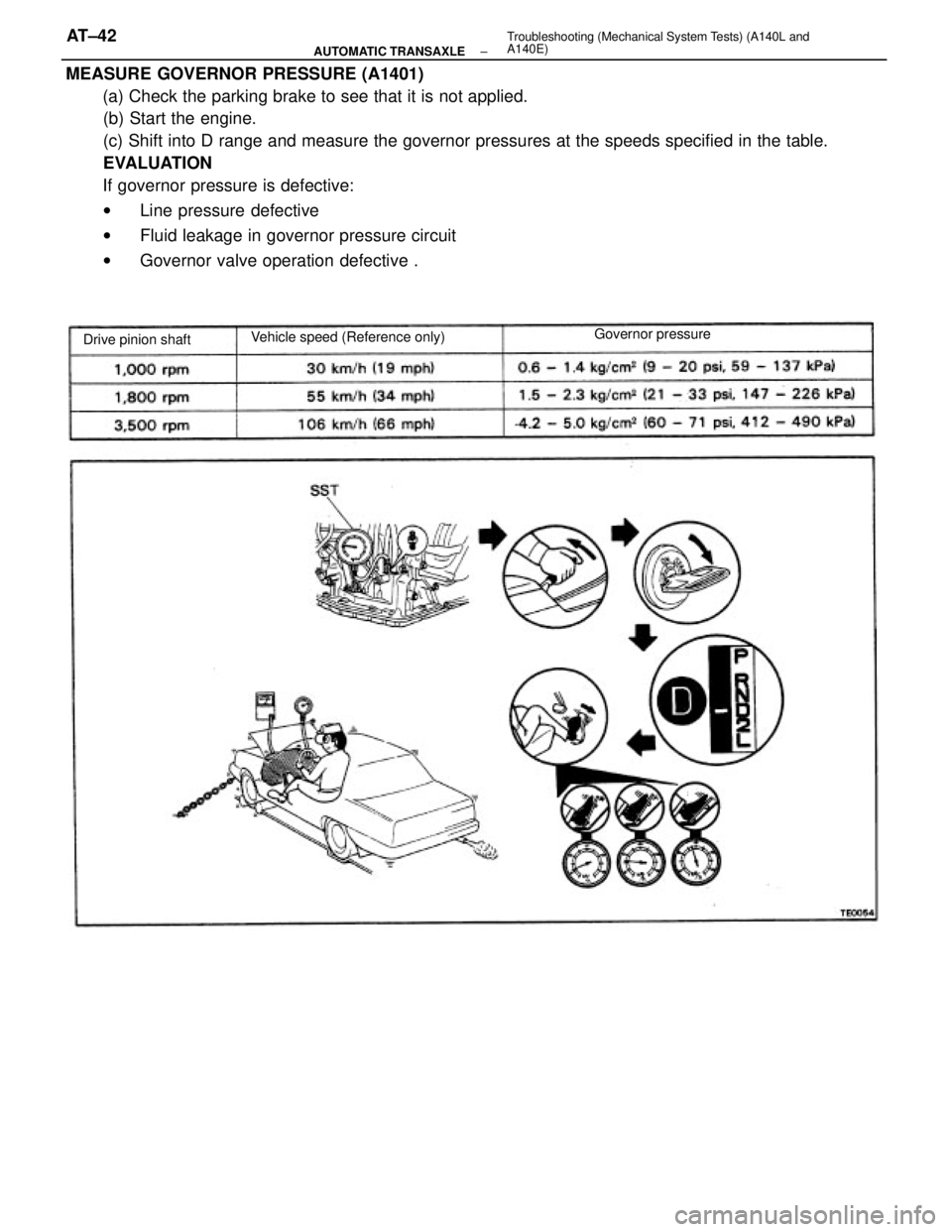
MEASURE GOVERNOR PRESSURE (A1401)
(a) Check the parking brake to see that it is not applied.
(b) Start the engine.
(c) Shift into D range and measure the governor pressures at the speeds specified in the table.
EVALUATION
If governor pressure is defective:
wLine pressure defective
wFluid leakage in governor pressure circuit
wGovernor valve operation defective .
Vehicle speed (Reference only)
Drive pinion shaftGovernor pressure
± AUTOMATIC TRANSAXLETroubleshooting (Mechanical System Tests) (A140L and
A140E)AT±42
Page 299 of 2389
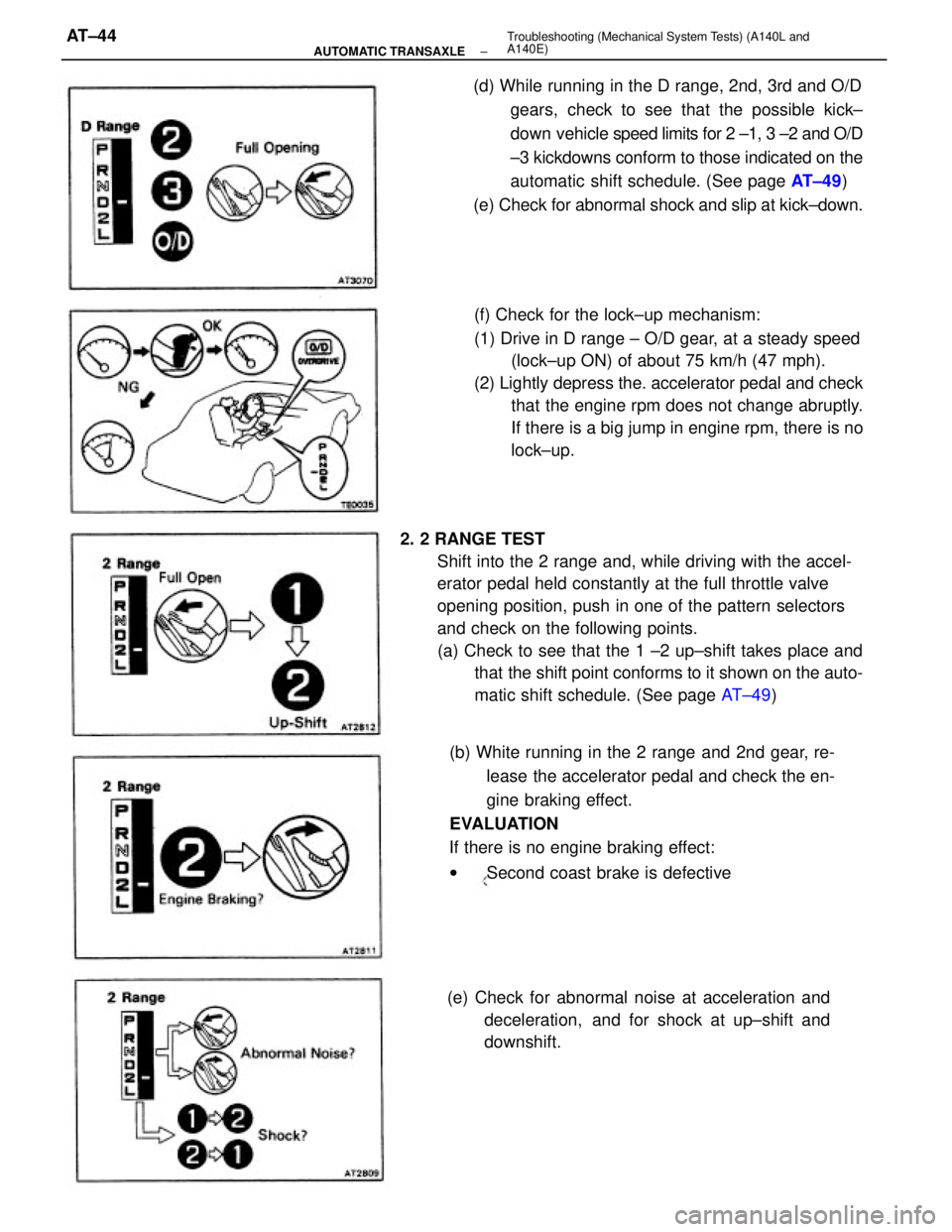
2. 2 RANGE TEST
Shift into the 2 range and, while driving with the accel-
erator pedal held constantly at the full throttle valve
opening position, push in one of the pattern selectors
and check on the following points.
(a) Check to see that the 1 ±2 up±shift takes place and
that the shift point conforms to it shown on the auto-
matic shift schedule. (See page AT±49)
(b) White running in the 2 range and 2nd gear, re-
lease the accelerator pedal and check the en-
gine braking effect.
EVALUATION
If there is no engine braking effect:
wSecond coast brake is defective (d) While running in the D range, 2nd, 3rd and O/D
gears, check to see that the possible kick±
down vehicle speed limits for 2 ±1, 3 ±2 and O/D
±3 kickdowns conform to those indicated on the
automatic shift schedule. (See page AT±49)
(e) Check for abnormal shock and slip at kick±down.
(f) Check for the lock±up mechanism:
(1) Drive in D range ± O/D gear, at a steady speed
(lock±up ON) of about 75 km/h (47 mph).
(2) Lightly depress the. accelerator pedal and check
that the engine rpm does not change abruptly.
If there is a big jump in engine rpm, there is no
lock±up.
(e) Check for abnormal noise at acceleration and
deceleration, and for shock at up±shift and
downshift.
± AUTOMATIC TRANSAXLETroubleshooting (Mechanical System Tests) (A140L and
A140E)AT±44
Page 300 of 2389
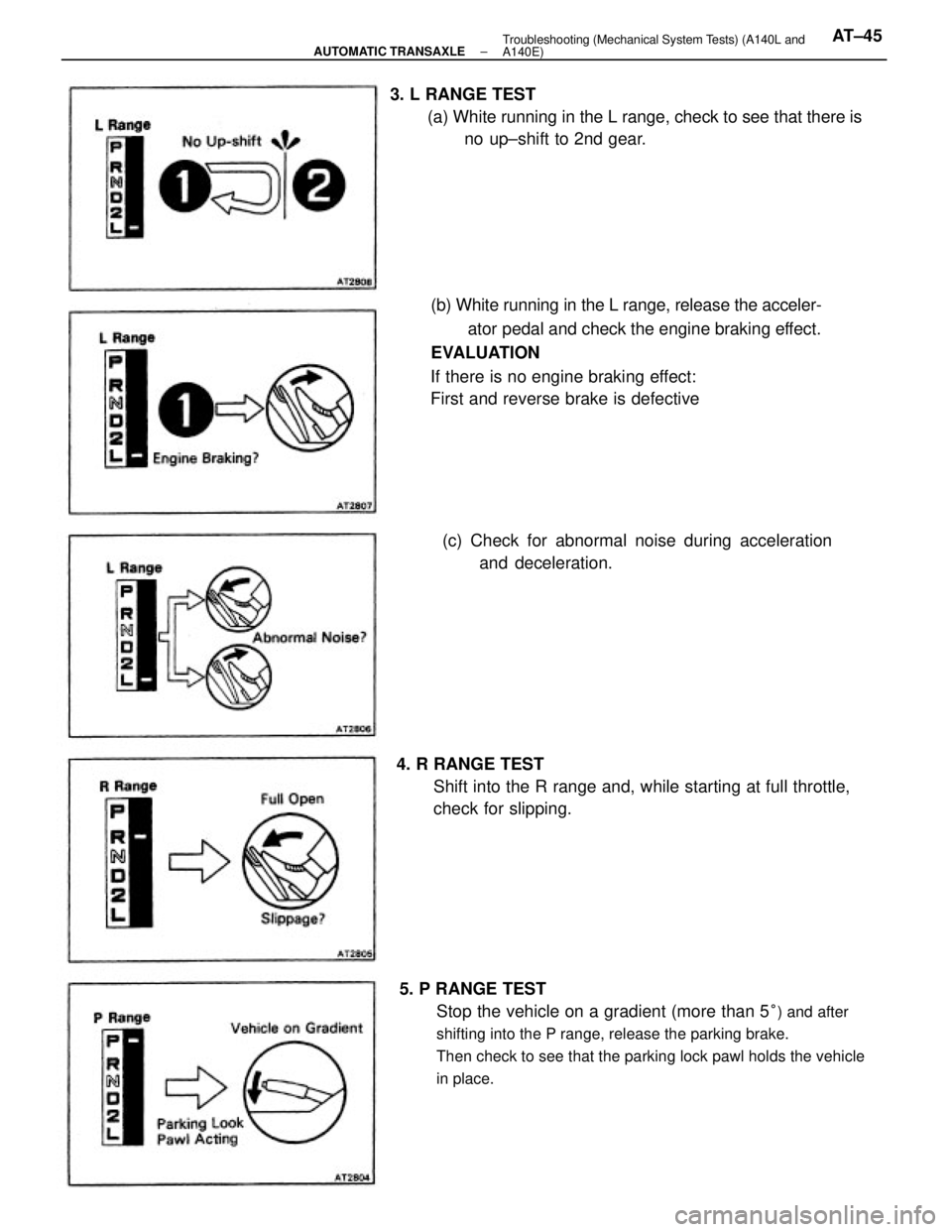
(b) White running in the L range, release the acceler-
ator pedal and check the engine braking effect.
EVALUATION
If there is no engine braking effect:
First and reverse brake is defective
5. P RANGE TEST
Stop the vehicle on a gradient (more than 5
°) and after
shifting into the P range, release the parking brake.
Then check to see that the parking lock pawl holds the vehicle
in place.
3. L RANGE TEST
(a) White running in the L range, check to see that there is
no up±shift to 2nd gear.
4. R RANGE TEST
Shift into the R range and, while starting at full throttle,
check for slipping.(c) Check for abnormal noise during acceleration
and deceleration.
± AUTOMATIC TRANSAXLETroubleshooting (Mechanical System Tests) (A140L and
A140E)AT±45